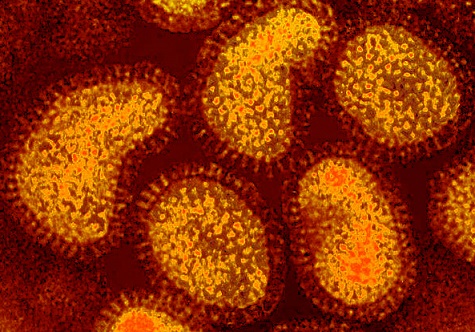New Zealand Study Unveils Role of Human Cellular Proteins HDAC1 and HDAC2 in Combating Influenza A Virus
Nikhil Prasad Fact checked by:Thailand Medical News Team Dec 30, 2024 3 months, 2 weeks, 1 day, 8 hours ago
Medical News: Influenza A virus (IAV) remains a persistent threat to global health, with the potential to cause pandemics. The virus’ capacity to mutate and spread across species emphasizes the importance of studying its interactions with the host’s immune defenses. Recently, researchers from the University of Otago in New Zealand have shed light on how two key cellular proteins, HDAC1 (Histone deacetylase 1) and HDAC2, play a role in combating IAV. Their findings could provide new avenues for antiviral treatments and enhance our understanding of how the body fights off infections.
 New Zealand Study Unveils Role of Human Cellular Proteins HDAC1 and HDAC2 in
New Zealand Study Unveils Role of Human Cellular Proteins HDAC1 and HDAC2 in
Combating Influenza A Virus
This
Medical News report delves into the study’s key findings, highlighting the significance of HDAC1 and HDAC2 in facilitating an effective immune response during IAV infections.
Background on Influenza A Virus and Immune Response
Influenza A virus is notorious for causing seasonal epidemics and occasional pandemics, primarily due to its ability to mutate rapidly. This variability enables the virus to evade immune responses and jump across species barriers. Infections caused by highly pathogenic subtypes, such as H5N1, have raised global concerns due to their severe impacts on human health.
The immune system’s first line of defense against such infections is the innate antiviral response. Central to this response are signaling molecules and pathways that detect the virus and activate transcription factors like STAT3. These factors regulate the expression of genes essential for halting viral replication. STAT3, a member of the STAT family, has emerged as a critical player in the immune response against IAV. Activated STAT3 translocates to the nucleus to initiate the production of antiviral proteins. However, the role of other cellular proteins, such as HDAC1 and HDAC2, in modulating STAT3 activity during viral infections has remained poorly understood.
The Study: Objectives and Methods
Researchers Jessica Leong and Matloob Husain aimed to uncover the role of HDAC1 and HDAC2 in regulating STAT3 activity during IAV infections. Using HeLa cells, they explored whether these histone deacetylases influence the nuclear translocation of STAT3 - a crucial step in its activation.
The study employed advanced microscopy techniques, genetic modifications, and biochemical assays to observe the behavior of STAT3 in infected cells. By depleting HDAC1 and HDAC2 using specific small interfering RNAs (siRNAs), the team investigated how these proteins affect STAT3 movement and function during IAV infection.
Key Findings
The study revealed several critical insights into the interplay between HDAC1, HDAC2, and STAT3:
-HDAC1 and HDAC2 Facilitate STAT3 Activation: In infected cells, STAT3 requires assistance from HDAC1 and HDAC2 to move into the nucleus. This
movement is essential for initiating the production of antiviral proteins.
-Depleting HDAC1 or HDAC2 Hinders STAT3 Function: When HDAC1 or HDAC2 expression was reduced, STAT3 failed to efficiently translocate to the nucleus in infected cells. This impaired the activation of genes responsible for combating the virus.
-Redundancy Between HDAC1 and HDAC2: Both proteins appeared to play overlapping roles in regulating STAT3. Their depletion resulted in similar disruptions to STAT3 nuclear translocation, suggesting a shared mechanism of action.
-HDACs Promote Antiviral Gene Expression: HDAC1 and HDAC2 indirectly enhance the immune response by facilitating STAT3’s activation and its ability to stimulate antiviral gene expression. These findings align with previous studies that identified HDACs as critical players in the host’s defense against various pathogens.
Implications of the Findings
The discovery that HDAC1 and HDAC2 are vital for STAT3 activation adds a new dimension to our understanding of the immune response. These proteins, traditionally known for their role in regulating gene expression by modifying chromatin structure, now emerge as key players in antiviral defense.
This research highlights potential therapeutic opportunities. For instance, drugs targeting HDACs could be refined to enhance their antiviral properties without compromising their other cellular functions. Such targeted therapies might bolster the immune system’s ability to fight off IAV and other viral infections.
Future Directions
While this study provides valuable insights, several questions remain unanswered. Future research should investigate:
-The specific mechanisms by which HDAC1 and HDAC2 regulate STAT3 activation.
-Do they act directly on STAT3, or do they influence other proteins involved in its signaling pathway?
-The role of HDAC1 and HDAC2 in different types of cells and across various IAV strains.
-The potential interplay between HDAC1/HDAC2 and other histone-modifying enzymes during viral infections.
Addressing these questions will help clarify the broader implications of HDAC activity in immune responses and guide the development of novel antiviral strategies.
Conclusion
The findings from the University of Otago researchers underscore the critical role of HDAC1 and HDAC2 in facilitating an effective immune response against influenza A virus. By promoting the activation and nuclear translocation of STAT3, these proteins help orchestrate the host’s defense mechanisms. This study not only enhances our understanding of the molecular underpinnings of IAV infections but also opens new avenues for developing targeted antiviral therapies.
Understanding the role of HDACs in immune responses highlights the intricate balance of cellular processes that protect us from infections. As researchers continue to uncover these complexities, the potential for innovative treatments that harness the body’s natural defenses becomes increasingly promising.
The study findings were published in the peer-reviewed journal: Viruses.
https://www.mdpi.com/1999-4915/17/1/33
For the latest Influenza News, keep on logging to Thailand
Medical News.
Read Also:
https://www.thailandmedical.news/news/covid-19-news-researchers-discover-protein-called-hdac3-as-the-orchestrator-of-the-immune-system-s-inflammation-response-to-infection-
https://www.thailandmedical.news/news/covid-19-news-cancer-drugs-such-as-hdac1-3-inhibitors-increases-sars-cov-2-replication-and-infection-in-lung-mesothelial-and-epithelial-cells
https://www.thailandmedical.news/news/hdac6-as-a-target-for-glioblastoma-multiforme-therapy
https://www.thailandmedical.news/news/hdac-(histone-deacetylase)-inhibitors-used-in-cancer-therapies-can-also-treat-human-papillomavirus-infections
https://www.thailandmedical.news/news/hdac9-gene-identified-as-playing-role-in-hardening-of-blood-vessel-walls
